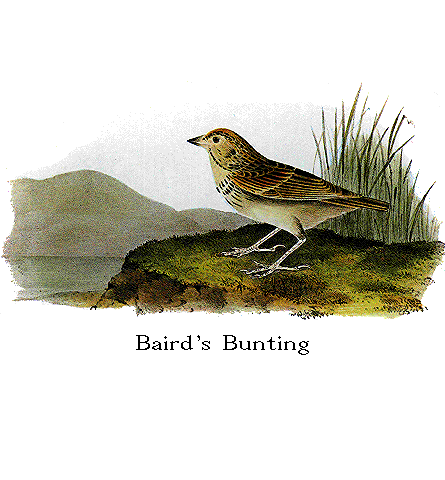 |
 

 |
|
Baird's Bunting
|
   |
 |
|
Search for products for sale only! |
Search entire site for specific information! |
|
|
| Bookmark - Add us to your Favorites |

BAIRD'S BUNTING.
[Baird's Sparrow.]
EMBERIZA BAIRDII, Aud.
[Ammodramus bairdi.]

PLATE D.--ADULT MALE.
During one of our Buffalo hunts, on the 26th July, 1843, we happened to pass along several wet places, closely over-grown by a kind of slender rush-like grass, from which we heard the notes of this species, and which we thought were produced by Marsh Wrens, (Troglodytes palustris,) and my friends HARRIS and JOHN G. BELL immediately went in search of the birds. Mr. BELL soon discovered that the notes of Baird's Bunting were softer and more prolonged than those of the Marsh Wren. They had much difficulty in raising them from the close and rather long grass, to which this species appears to confine itself; several times Mr. BELL nearly trod on some of them, before the birds would take to wing, and they almost instantaneously re-alighted within a few steps, and then ran like mice through the grass. After awhile, however, two were shot on the wing, and both fortunately were found, and proved to be an adult male and female. We found this species abundant in all such situations as I have mentioned above, and doubtless it breeds in them.
I have named this species after my young friend SPENCER F. BAIRD, of Carlisle, Pennsylvania.
BAIRD'S BUNTING, Emberiza Bairdii, Aud.
Wet portions of the prairies of the Upper Missouri.
Male.
Bill stout and longish; wings rather long and broad, the second quill the longest, and the four first nearly equal; tail emarginate and rounded, with the feathers acute. Upper parts light yellowish-brown, streaked with brownish-black; the margins of the feathers on the back and scapulars slightly tinged with light reddish-cream colour, the edge of the wing paler, as well as those of the tail feathers. A broad streak of reddish-cream colour on the centre of the head, surrounded by rows of blackish-brown, as well as a line from the corner of the lower mandible; a semilunar line of spots and streaks of the same on the upper part of the breast and sides of the body. Legs and feet very stout and rather long, claws long, slender, curved and acute. Bill horn colour toward the tip and dull yellow; cheeks and all under parts pale dull yellowish-white.
Bill along the ridge 1/2 inch, along the edge 5/8; wing from flexure 2 inches and 3/4; tail 2 1/8; tarsus 7/8; hind toe 3/8, its claw 3/8; middle toe 5/8, its claw 1/4. The whole light flesh colour and transparent, eye hazel.

